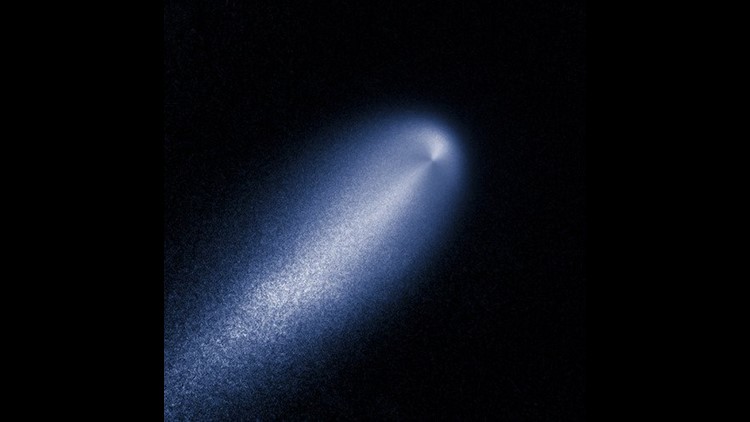(CNN) — ISON, the most closely watched comet in recent years, may be falling apart as it nears its close encounter with the sun.
Comets are giant snowballs of frozen gases, rock and dust that can be several miles in diameter. When they get near the sun, they warm up and spew out some of the gas and dirt, creating a tail that can stretch for thousands of miles. Most comets are in the outer part of our solar system. When they get close enough for us to see them, scientists study them for clues about how our solar system formed.
When ISON was first discovered, hopes were high that it might become visible to the naked eye, meaning everyone might be able see it, not just those with good telescopes who took the trouble to find it. There was talk it might even rival some of the Great Comets like Halley’s or Hale-Bopp and spread a huge tail across the sky.
But some observers on Tuesday reported online that the comet is not nearly as bright as it has been in recent days and that it may be pouring out dust.
This could mean the comet’s core, or nucleus, has “completely disrupted, releasing an enormous volume of dust,” NASA’s Comet ISON Observing Campaign says in its November 25 online update.
But other observers say images taken by NASA’s STEREO spacecraft are “encouraging evidence that the comet still exists,” Padma Yanamandra-Fisher with the ISON campaign told reporters on the campaign’s Facebook page. She added that it’s too early to tell what kind of shape the comet is in, though.
“I believe the next couple of days will be crucial to determine the post-perihelion appearance of the comet,” Yanamandra-Fisher said. Perihelion is the point in an object’s path that is closest to the sun.
Whatever its final fate, she said, ISON has “provided a wonderful window into the world of comets. The full understanding of this comet and its place in the taxonomy of comets will only come in hindsight.”
ISON was discovered in September of 2012 by astronomers Vitali Nevski and Artyom Novichonok using a telescope near Kislovodsk, Russia, that is part of the International Scientific Optical Network (ISON). ISON — officially named C/2012 S — was 585 million miles away at the time. Its amazing journey through the solar system has been chronicled by amateur astronomers and by space telescopes. NASA has even created a toolkit for ISON fans.
Confusion about its fate isn’t new for ISON watchers.
“From the moment of discovery, ISON has been a confusing, frustrating, dynamic and unpredictable object. In other words, it has been a very typical comet!” said Karl Battams, an astrophysicist with the Naval Research Laboratory in Washington.
The glare of the sun has blocked most ground-based observations, but NASA has a fleet of spacecraft watching as ISON plunges toward the sun. If it hasn’t already broken up, it will skim about 730,000 miles above its surface on Thanksgiving Day and could put on a sky show in early December when it moves out of the glare of the sun.
The comet will make its closest approach to Earth on December 26, and, no, it won’t hit us. But for now, we wait to learn ISON’s fate.
“I am excited at marking the progress of this comet that has captivated the world from its discovery and the possibility of it being a Great Comet,” Yanamandra-Fisher told CNN.com. “I am glad that I was able to be part of its journey.”



